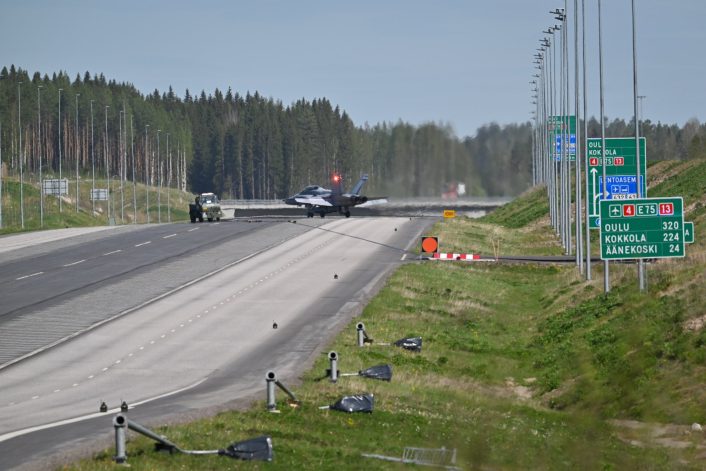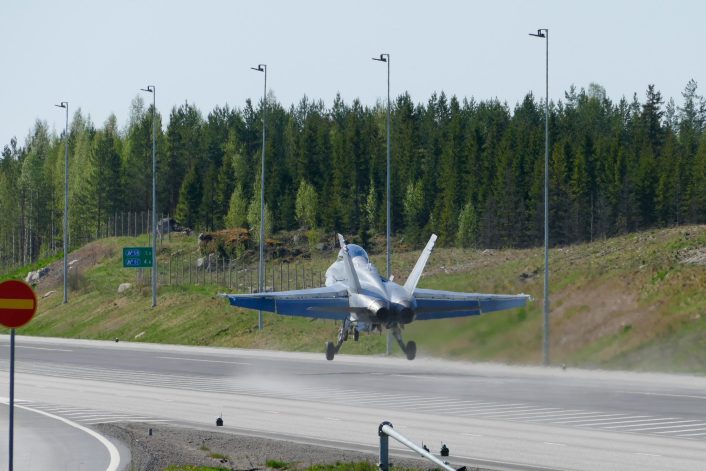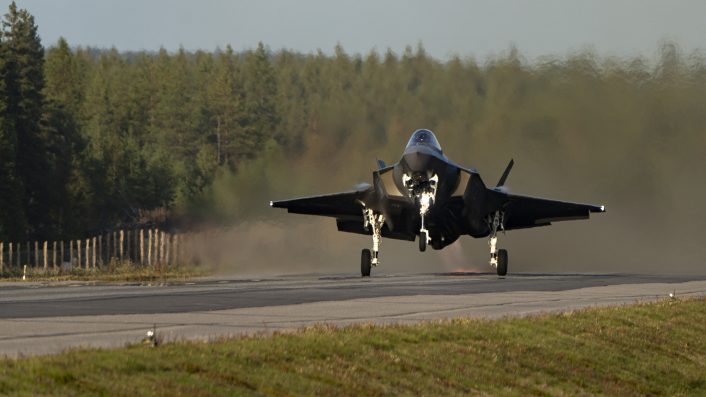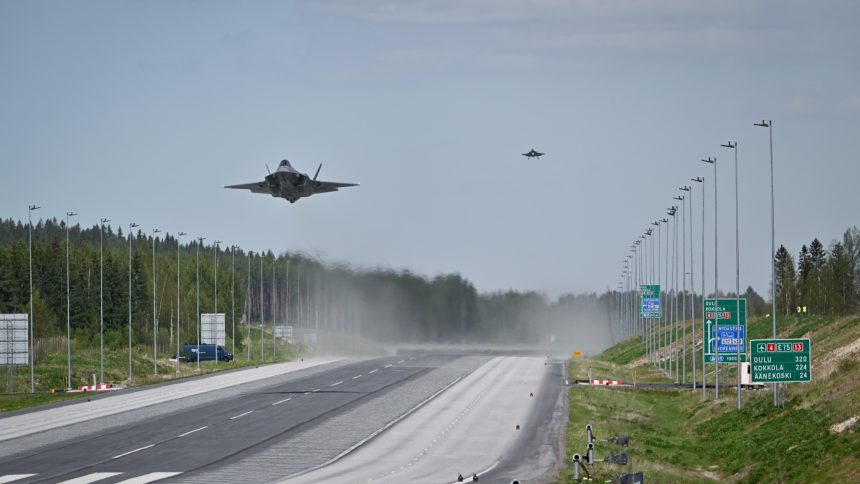Royal Netherlands Air Force F-35A Lightning II fighter jets are taking part in the Baana 25 exercise underway in Finland.
The Royal Netherlands Air Force joined this year’s edition of the Baana highway exercise in Finland, deploying a number of F-35A Lightning II jets. The 5th generation aircraft are taking part to highway operations alongside the aircraft of the Finnish Air Force, including F/A-18 Hornets, Hawks and Learjets.
Baana, the yearly dispersed operations drills of the Finnish Air Force, already saw the F-35 in action last year, specifically two F-35A jets belonging to the U.S. Air Force’s 495th Fighter Squadron, and in 2023 when Royal Norwegian Air Force’s F-35 took part in Baana 23. The landing on Hosio Highway Strip, Ranua, during Baana 24 marked the first time in history a U.S. fighter aircraft operated on a Finnish highway strip.
The Finnish Air Force exercise #Baana25 has started today. During the exercise, troops are trained to operate on a highway strip, to use the Air Force’s concept of dispersed operations & to cooperate with Allies. This time, Baana also involves Allied F-35As from @Kon_Luchtmacht. pic.twitter.com/YpwKSv7w9C
— Ilmavoimat (@FinnishAirForce) May 26, 2025
For Baana 25, the highway operations are being conducted on the Highway 4 near Tikkakoski from May 26 to 29. “During the Baana exercise, troops are trained to operate on a highway strip, to use the Air Force’s concept of dispersed operations, and to cooperate with Allies,” said the Finnish Air Force in a press release.
The Royal Netherlands Air Force F-35A fighter jets are participating in the exercise #Baana25 at Tikkakoski for the first time. Alongside the touch-and-go landings, @Kon_Luchtmacht🇳🇱 is conducting fighter integration training w/ 🇫🇮 F/A-18 fighters, operating out of Pirkkala AFB. pic.twitter.com/JbHJrW6iGy
— Ilmavoimat (@FinnishAirForce) May 26, 2025
After the end of the first day of flight operations, the service released some photos and videos on social media. The F-35s were shown conduction touch and go operations, although it is unclear if they also landed to refuel and later departed again from the highway.
Mitä tehdä, jos kiitotie on vaurioitunut vihollisen ohjusiskussa? 🛫💥
Jos osa kiitotiestä on kunnossa, voidaan käyttää vaijeripysäytysjärjestelmää. 🇫🇮 F/A-18 Hornet -hävittäjät testasivat tätä suorituskykyä #Baana25-harjoituksessa Tikkakoskella.#ilmavoimat #ilmask #WeAreNATO pic.twitter.com/P3F8ysZUxG
— Ilmavoimat (@FinnishAirForce) May 28, 2025
Finland employed its frontline fighter, the F/A-18 Hornet, which apparently also used its arresting hook to quickly stop after landing. Other assets involved are the Hawk Mk.51 and Mk.66 trainers and the Learjet 35, according to the images released.

The Baana 25 exercise
Baana, known in NATO as “Imminent Field,” is the Finnish Air Force’s annual exercise focused on road base operations. According to the Finnish Air Force, the exercise is part of Finland’s strategy to maintain readiness by dispersing aircraft across various locations outside main bases, enhancing operational flexibility.
Tänään alkaneessa #Baana25-harjoituksessa joukot harjaantuvat maantietukikohdassa toimimisessa. Ilmavoimien kaluston lisäksi mukana on Alankomaiden kuninkaallisten ilmavoimien F-35A-hävittäjiä. 🇫🇮🇳🇱#ilmavoimat pic.twitter.com/MC5ziP1rZL
— Ilmavoimat (@FinnishAirForce) May 26, 2025
During Baana 25, flight operations will be conducted from May 26 to 29. Activities include take-offs and landings on a highway strip prepared on the Highway 4/E75 by F/A-18 Hornets, Hawk trainers, and support aircraft, with participation of Dutch F-35 fighter jets.
Anytime, Anywhere, Airpower👊🏽#FightTonightTomorrowTogether @Kon_Luchtmacht @Defensie @NATO pic.twitter.com/GcA7G4OAC0
— André Steur (@andresteur) May 27, 2025
The RNLAF F-35s are operating out of Pirkkala Air Force Base, home of the Satakunta Air Wing. The base is about 180 km south-west of Tikkakoski, where the highway strip is located.
The Finnish Air Force’s Baana 25 exercise has kicked off today. This week, the Air Force is operating from the Tikkakoski highway strip on E75, training in line with its mobile and dispersed battle concept. #ilmavoimat #baana25 pic.twitter.com/sr304XO1gZ
— Ilmavoimat (@FinnishAirForce) May 26, 2025
Similarly to what did U.S. and Norwegian F-35s in the previous years, the Dutch F-35s will implement Agile Combat Employment capabilities by learning austere environment aircraft landing and take-off operations and techniques from their Finnish counterparts. While in Finland, the F-35s will also conduct fighter integration training with the F/A-18s, said the Finnish Air Force.

Highway operations and Agile Combat Employment
After World War II and throughout the Cold War, several countries, particularly in Eastern Europe, adopted the concept of highway strips—designated sections of highways or public roads that could be used as runways. This approach aimed to address the vulnerability of airbases, whose locations were well-known and would likely be targeted early in any conflict.
In the last decade, there has been a resurgence in training for dispersed operations, including highway landings, as seen with Finnish, Swedish, Swiss and U.S. drills. More recently, the war in Ukraine has shown how airfields, even those located quite far from the battlefront, can be vulnerable to attacks conducted with drones.
Nelostien Baanan maantietukikohdan laskukierroksessa F-35A, Hornet, Hawk ja Learjet https://t.co/2MdcYmqFSC #Baana25 #Tikkakoski #Nelostie #roadbase @FinnishAirForce #Hornet @Kon_Luchtmacht #F35A #turpo pic.twitter.com/gozeo7HUVf
— lentoposti.fi (@lentopostifi) May 26, 2025
In fact, the war in Ukraine further highlighted the need to reinforce the ability to perform Agile Combat Employment (ACE) operations. The U.S. Air Force introduced this concept well before the start of the war in 2022, as part of its own adaptation of the Dynamic Force Employment (DFE) used by the U.S. military as a whole.
DFE is the new strategy that combines strategic unpredictability with operational adaptability, first introduced by the 2018 National Defense Strategy. The key concept is to be operationally unpredictable in order to disrupt an adversary’s ability to respond and target allied forces.
In its press releases, the Air Force mentioned in the past that DFE operations fall under the ACE capabilities which allow to “improve passive and active defense capabilities to ensure a competitive advantage and to protect assets and personnel in the future.” Specifically, the Agile Combat Employment has been defined by the Air Force in its doctrine as “a proactive and reactive operational scheme of maneuver executed within threat timelines to increase resiliency and survivability while generating combat power.”

ACE essentially involves operating from austere airfields, large roads and highways with little supporting and technical infrastructure, dispersing assets out from the larger air bases that are likely to come under a sudden volume of Russian or Chinese tactical ballistic and cruise missiles. The strategy, while complicating adversary planning, also allows to hold adversary targets at risk from multiple locations.
The renewed interest in dispersed operations, including highway operations, testifies to the evolution of military strategies in response to contemporary threats in the current volatile geopolitical environment. The advent of technologies such as drones and ballistic and cruise missiles, as seen in current conflicts, has made traditional air bases more vulnerable, necessitating the search for more flexible and resilient alternatives.
The ACE concept, which could be considered as a modern take on the similar Cold War tactic, contributes to improving the survivability, responsiveness, and combat power of air forces in contested environments. The war in Ukraine has further highlighted the relevance of this concepts, demonstrating the need to adapt military doctrines and infrastructures to the changing dynamics of the battlefield.
These concepts are now gradually being integrated in the standard operations of many European air forces, which periodically practice them during exercises. An example of this is the recent Pégase 25 of the French Air and Space Force, which saw Rafales and other assets being quickly deployed to different locations throughout Europe.
Highway operations were also practiced by Switzerland in 2024, with F/A-18s landing on the A1 motorway during the Alpha One exercise. Also recently, the Royal Air Force and Italian Air Force practiced together the hot refueling of their Typhoons in Italy.









